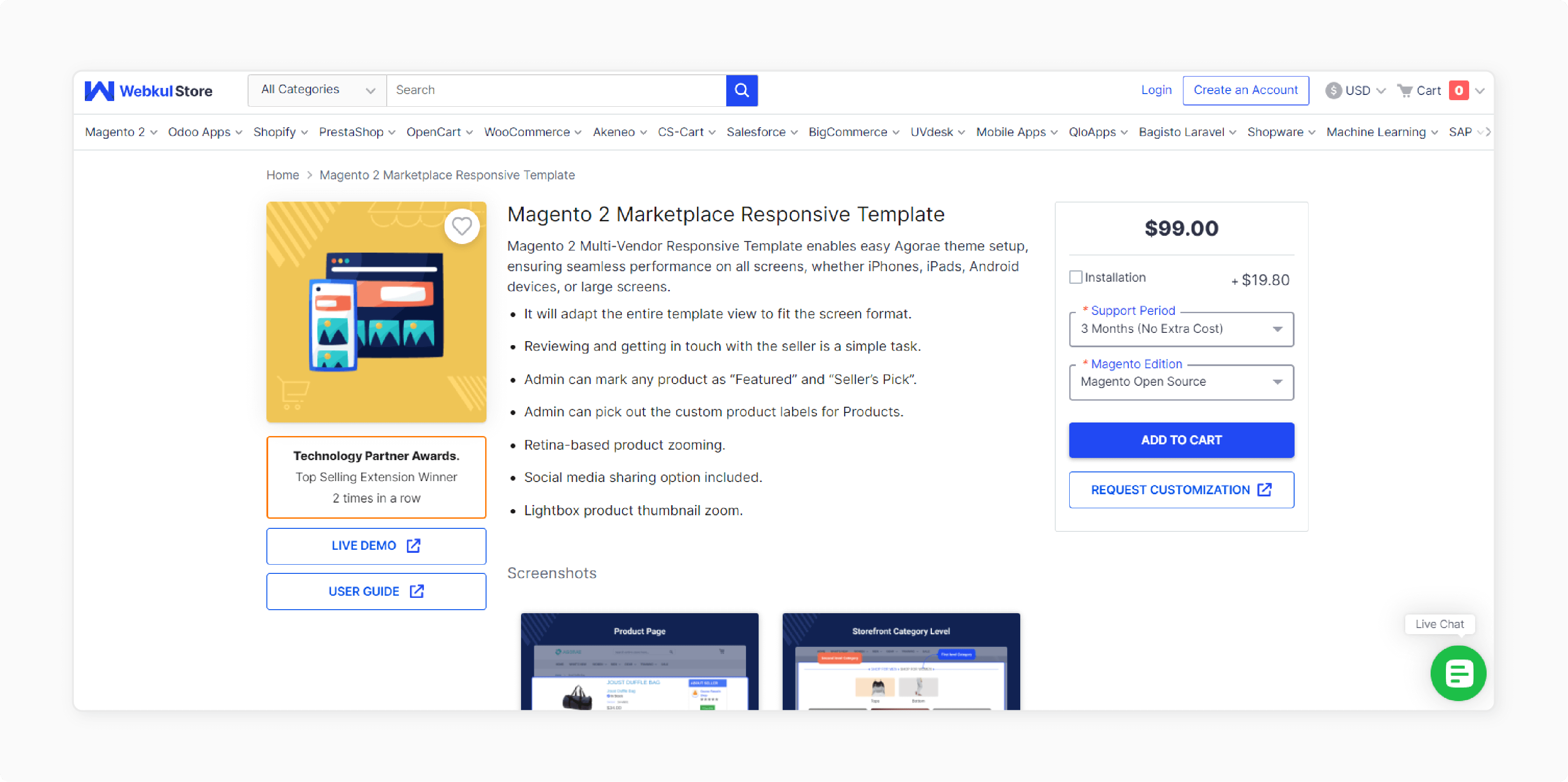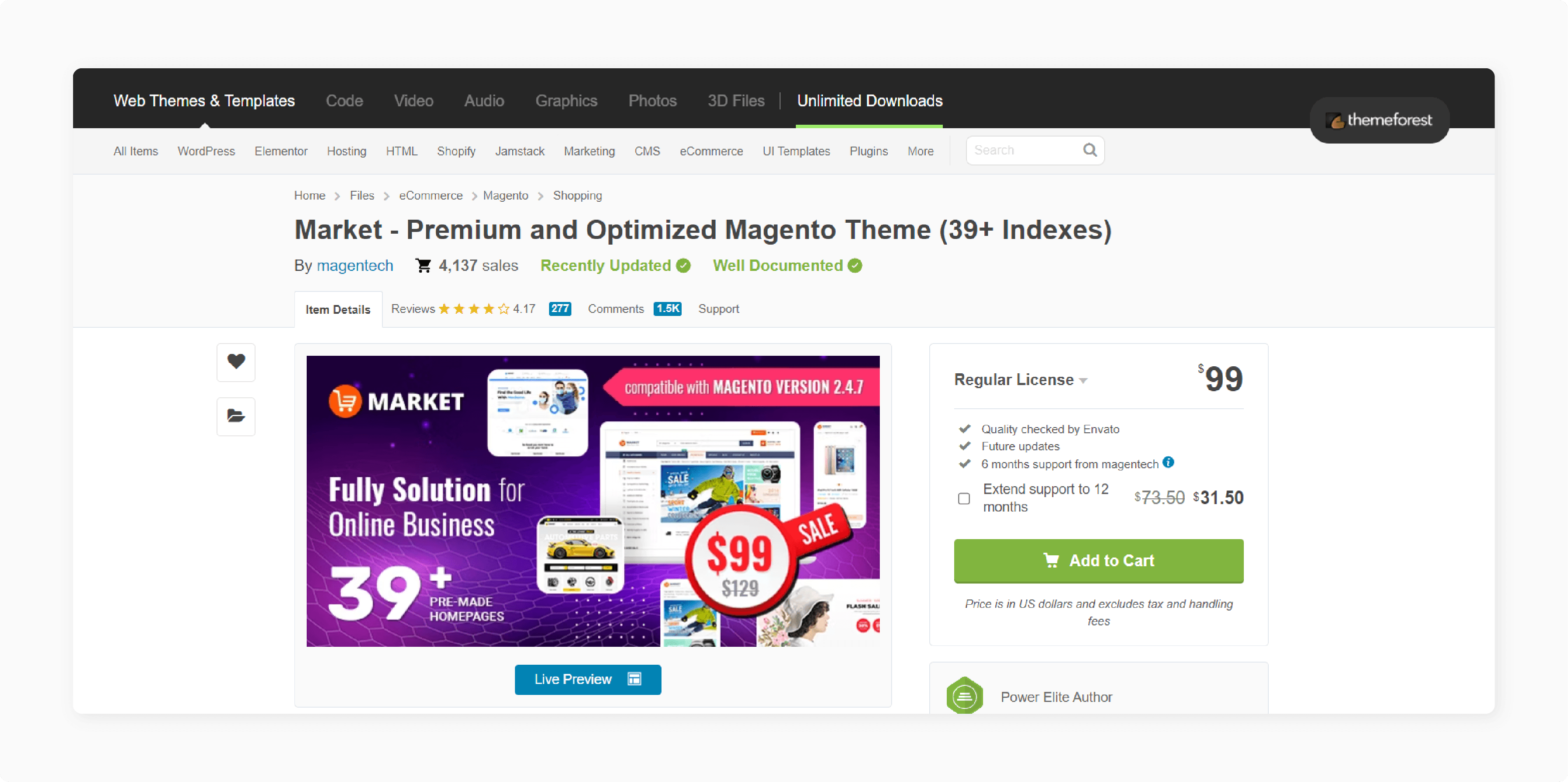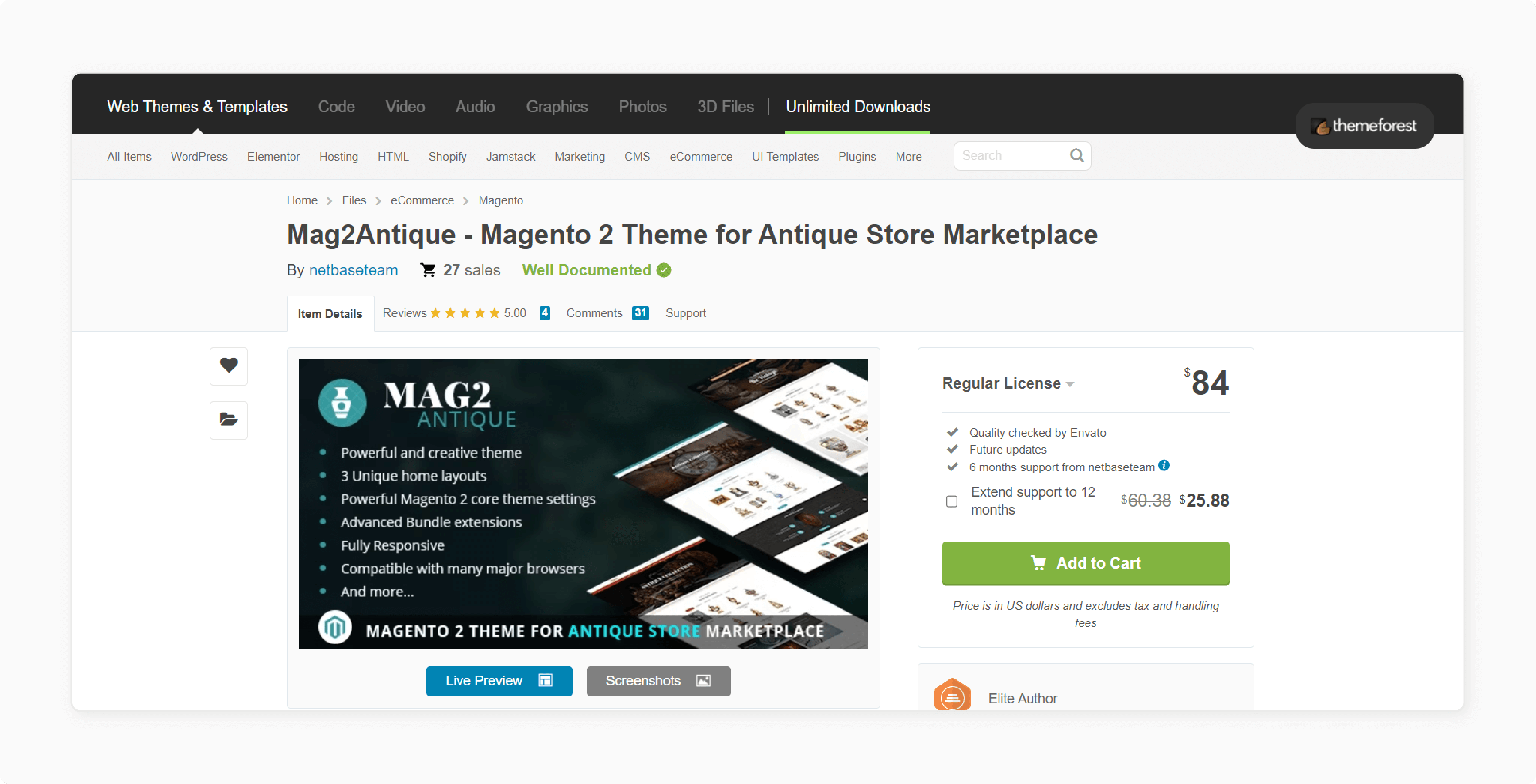
Magento 2 Multi Vendor Marketplace Theme: Top Themes and Key Features
Looking to create an online marketplace with multiple vendors on Magento 2? Magento 2 multi vendor marketplace theme enhances vendor autonomy and offers smooth transactions and scalability.
In this article, we will explore the key features and top Magento 2 multi-vendor marketplace themes.
Key Takeaways
-
What is Magento 2 Multi Vendor Marketplace Theme?
-
Top Magento 2 themes like Webkul’s Responsive Template and Magentech’s Premium Theme.
-
Essential Magento 2 Multi Vendor features such as vendor dashboard management and commission management.
-
Differences between Magento 2 multi-vendor marketplace themes and extensions.
-
Insights into SEO optimization, responsive design benefits, and support for multi-currency operations.
-
How to Optimize Product Catalog in Your Magento 2 Multi Vendor Marketplace
-
Difference Between Magento 2 Multi Vendor Marketplace Theme and Extensions
What is Magento 2 Multi Vendor Marketplace Theme?
Magento 2 multi-vendor marketplace theme refers to a specialized theme. It is designed to create an online marketplace. It is where multiple vendors can sell their products on a single Magento 2 platform.
It includes various features within a cohesive design optimized for both vendors and customers. The theme typically integrates with Magento's multi-vendor extensions. These facilitate the smooth operation of the marketplace.
How to Optimize Product Catalog in Your Magento 2 Multi Vendor Marketplace
1. Product Information Management (PIM)
-
Consistent Product Data: Ensure product data is consistent and accurate across all vendors. Use a PIM system to manage and synchronize product information.
-
Detailed Descriptions: Provide detailed and clear product descriptions. It highlights key features, benefits, and specifications.
-
High-Quality Images: Use high-resolution images with zoom functionality. It includes multiple images showing different angles and product usage.
2. Category Management
-
Logical Categorization: Organize products into logical categories and subcategories. It helps customers to find what they are looking for.
-
Faceted Navigation: Implement faceted navigation. It allows customers to filter products by attributes such as:
-
Size
-
Color
-
Brand
-
Price
- Breadcrumbs: Use breadcrumbs to enhance navigation and improve the user experience.
3. Inventory Management
-
Real-Time Stock Updates: Ensure inventory levels are updated in real-time to prevent overselling and stockouts.
-
Low Stock Alerts: Set up low stock alerts to notify vendors when products are running low. It allows them to replenish stock in a timely manner.
4. Product Variants and Custom Options
- Product Variants: Offer product variants within the same product listing. These include different:
-
Sizes
-
Colors
-
Materials
- Custom Options: Allow vendors to add custom options to products. It provides more choices to customers.
5. Advanced Search Functionality
-
Autocomplete Search: Implement autocomplete search to help customers find products quickly.
-
Advanced Filters: Provide advanced filters to refine search results based on various criteria.
-
Synonyms and Misspellings: Account for synonyms and common misspellings in the search functionality to improve search accuracy.
6. Pricing Strategies
-
Competitive Pricing: Encourage vendors to set competitive prices and offer discounts and promotions.
-
Dynamic Pricing: Use dynamic pricing strategies. It adjusts prices based on:
-
Demand
-
Competition
-
Other factors
Key Features of Magento 2 Multi Vendor Marketplace Theme
1. Vendor Dashboard
- The vendor dashboard is a central hub. It is where sellers can manage all aspects of their business within the marketplace. It includes:
-
Adding new products
-
Updating existing listings
-
Managing inventory levels
- Vendors can handle their operations without needing direct intervention from the marketplace administrator.
2. Product Management
- Vendors have comprehensive control over their product listings. They can make them discoverable by customers by:
-
Uploading product images
-
Setting prices
-
Describing features
-
Categorizing items
- Advanced options often include bulk product uploads and batch updates. It streamlines the management of large inventories.
3. Commission Management
-
The feature automates the calculation and collection of commissions from vendors. It is for each sale made through the marketplace.
-
Administrators can set commission rates based on various criteria, such as:
-
Product categories
-
Vendor performance metrics
- It ensures fair revenue sharing and transparent financial transactions.
4. Order Management
- Vendors can process and fulfill orders placed by customers. They:
-
Receive notifications of new orders
-
Manage order status updates like processing, shipping, and delivery.
-
Provide tracking information
- It supports integration with shipping carriers to streamline the fulfillment process.
5. Payment Gateways
-
Integration with multiple payment gateways ensures secure and reliable transaction processing.
-
Vendors can choose from various payment methods, including:
-
Other regional payment systems
- It helps provide flexibility to customers based on their preferences and location.
6. Rating and Reviews
-
Customer feedback helps build trust and credibility within the marketplace. Vendors and their products receive ratings and reviews from customers.
-
These are then displayed to help prospective buyers make informed purchasing decisions. Positive reviews can boost sales and vendor reputation.
7. Multi-language and Currency Support
-
The theme supports multiple languages and currencies to cater to a global audience.
-
Vendors can list their products in different languages. Customers can browse and purchase items using their preferred currency.
-
The flexibility removes barriers to international trade and expands market reach.
8. Customizable Themes
- Marketplace administrators can align the theme with their business identity by customizing its:
-
Appearance
-
Layout
-
Colors
-
Branding elements
- The customization capability allows for a unique marketplace experience. It reflects the marketplace's niche, values, and target audience preferences.
Top Magento 2 Multi-Vendor Marketplace Themes
1. Magento 2 Marketplace Responsive Template - Webkul

Webkul’s Multi-Vendor Responsive Template enables easy Agorae theme setup. It ensures smooth performance and compatibility on all screens, including:
-
iPhones
-
iPads
-
Android devices
-
Large screens
The theme offers powerful vendor management tools. It allows multiple vendors to register and manage their products independently. It supports various payment gateways, facilitating smooth transactions between vendors and customers.
It is ideal for creating versatile multi-vendor marketplaces. It is where vendors need flexibility in managing their storefronts. It also helps maintain a brand experience.
Features:
-
The entire template view fits the screen format
-
Reviewing and getting in touch with the seller is simple
-
Manages commission structures transparently
-
Admin can mark any product as Featured, and Seller’s Pick
-
Admin can pick out the custom product labels for Products
-
Retina-based product zooming
-
Social media sharing option included
-
Lightbox product thumbnail zoom
Price:
-
Magento Open Source Edition: $148 (12 months)
-
Magento Adobe Commerce Edition: $297 (12 months)
2. Market Premium and Optimized Magento Theme - Magentech

Magentech’s market premium theme is a responsive Magento 2 & 1.9 theme. It is fully customizable and suitable for online stores. It is especially for multi-category stores with multiple branches and products. The theme is known for its performance optimization, prioritizing speed, and efficiency.
It allows Magento marketplace operators to tailor the user interface and functionality to specific business needs. The theme integrates with Magento, using its powerful ecommerce capabilities. It provides a user-friendly vendor dashboard.
It is suitable for high-traffic marketplaces that demand powerful performance and scalability. These stores are also focused on customization and user experience.
Features:
-
Vertical mega menu with multiple columns
-
Static blocks with a nice image and texts
-
SM tab listing with slider
-
SM categories with the display image
-
Layered navigation ajax
-
Multi-language and multi-currency support
-
Customer support tools
Price: $99 (12 months)
3. Mag2Antique Magento 2 Theme for Antique Store Marketplace - NetBaseTeam

NetBaseTeam’s Mag2Antique theme is created for online shops selling antique items. These include antique furniture, art, vintage glass, and pottery. The theme is built on a strong and flexible core with many features. It features an elegant and visually appealing design. The theme enhances your store’s stunning work, flexibility, and usability.
The use of original typography, high-quality images, and different antique decorative elements make our theme stand out from many competitors. It is compatible with Magento 2.2.9, 2.2.8, 2.2.7.
It is perfect for niche marketplaces specializing in antique products. These focus on aesthetic appeal, detailed catalog management, and specialized customer interaction.
Features:
-
Vendor-specific catalog management tools
-
Comprehensive customer support
-
Revolution slider, Ajax Cart Pro, and Ajax search
-
Mega menu and quick view
-
One-step checkout and blog module
-
FAQs feature, store Locator, and layered navigation
Price: $84 (12 months)
Difference Between Magento 2 Multi Vendor Marketplace Theme and Extensions
| Feature | Magento 2 Multi Vendor Marketplace Theme | Magento 2 Marketplace Extension |
|---|---|---|
| Core Functionality | It provides a complete theme designed for multi-vendor marketplaces. The various sections include vendor management, storefronts, and commission handling. | It adds a specific functionality to an existing e-commerce store. It enables multi-vendor capabilities. It usually focuses on vendor management, commission handling, and front-end features. |
| Vendor Management | It offers built-in tools for vendors. It allows them to register and manage products, orders, and payments. Admin controls vendor approvals, commissions, and payouts. | It adds vendor management capabilities to Magento. It allows the admin to manage vendor approvals, commissions, and payments. |
| Commission Handling | It calculates and manages commissions from vendor sales. It often includes automated payout features. | It handles commission calculations and vendor payouts. Magento store’s payment system integrates them. |
| Payment Integration | It supports multiple payment gateways for both store-wide and vendor-specific transactions. | It integrates with various payment gateways to facilitate vendor transactions. It helps ensure secure payments. |
| Scalability | It offers scalable architecture. It handles growth in vendor numbers and product offerings. | It enhances Magento's scalability by accommodating multiple vendors and their product catalogs. |
| Customization | It offers customization options tailored to marketplace needs. These include branding and front-end adjustments. | It allows customization of marketplace features and appearance within the Magento environment. |
| Complexity | It is more complex as it manages multiple vendors, transactions, and commissions. It requires marketplace management expertise. | It simplifies setup compared to themes. It integrates specific functionalities without altering core Magento functionality. |
| Support | It requires support for vendor-specific issues, storefront setup, commission disputes, and payment integrations. | It provides support for the installation and setup. It also integrates marketplace functionalities into the Magento 2 store. |
FAQs
1. What features does a Magento 2 Multi Vendor Marketplace Theme offer for invoicing?
It includes built-in invoicing features. It allows vendors to generate invoices for their sales transactions. It is from their vendor dashboards. The feature ensures transparent and efficient financial management.
2. Is a Magento 2 Multi Vendor Marketplace Theme compatible with multilingual capabilities?
Magento 2 Multi Vendor Marketplace Theme supports multilingual functionality. It enables vendors to list their products in multiple languages. It caters to diverse customer bases and enhances global market reach.
3. How versatile is a Multipurpose Magento 2 theme for multi-vendor marketplaces?
A Multipurpose Magento 2 theme designed for multi-vendor marketplaces offers extensive flexibility. It allows vendors to manage separate storefronts and customize their product listings. It also helps them tailor their branding to meet specific business needs.
4. How does a Magento 2 Multi Vendor Marketplace Theme ensure separate vendor management?
A Magento 2 Multi Vendor Marketplace Theme provides separate vendor management capabilities. It allows individual vendors to manage their products, orders, and customer interactions. It is through dedicated vendor dashboards ensuring streamlined operations and vendor autonomy.
Summary
Magento 2 multi vendor marketplace themes empower vendors on a single platform. It enhances their scalability and user experience. The article explores several points, including:
-
Themes like Webkul and Magentech offer powerful vendor management.
-
Features include comprehensive product, order management, and multi-language support.
-
Themes differ from extensions by providing complete design solutions tailored for multi-vendor operations.
-
It addresses the setup, management, and benefits of Magento 2 multi-vendor marketplace themes.
Explore enhanced vendor autonomy and scalability with Magento multi-vendor marketplace themes in managed Magento hosting.








